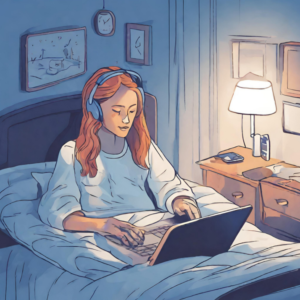 In our fast-paced, tech-driven world, the glow of screens has become an inescapable part of our daily lives. From smartphones to laptops, we are constantly bathed in the blue light emitted by our devices. While this has undoubtedly revolutionized the way we work, communicate, and entertain ourselves, it also comes with a hidden cost: disrupted sleep patterns.
In our fast-paced, tech-driven world, the glow of screens has become an inescapable part of our daily lives. From smartphones to laptops, we are constantly bathed in the blue light emitted by our devices. While this has undoubtedly revolutionized the way we work, communicate, and entertain ourselves, it also comes with a hidden cost: disrupted sleep patterns.
The link between blue light exposure and sleep disruption is well-established. Blue light, with its short wavelength and high energy, suppresses melatonin production more than other wavelengths. Melatonin is the hormone responsible for regulating sleep-wake cycles, and its suppression can throw our circadian rhythm, our internal body clock, out of sync.
So, why is this a big deal? Well, the consequences of poor sleep go beyond mere fatigue. Chronic sleep disruption has been linked to a range of health issues, including obesity, diabetes, and cardiovascular problems. It also impacts cognitive function, mood, and overall well-being. Therefore, finding ways to mitigate blue light exposure and prioritize sleep is crucial for our health and quality of life.
Here are three actionable tips to help you navigate the challenge of blue light and enhance your sleep hygiene:
Embrace the Warm Glow of Night Mode:
Most devices now come equipped with a night mode feature that reduces blue light emission during evening hours. Enabling this mode on your smartphone, tablet, or computer can significantly diminish your exposure to sleep-disrupting blue light. Night mode adjusts the color temperature of your screen towards the warmer, reddish end of the spectrum, mimicking the natural progression of sunlight throughout the day. By making this a habitual part of your evening routine, you signal to your body that it’s time to wind down.
Invest in Blue Light Blocking Glasses:
If you find yourself working late into the night or exposed to artificial light sources, consider investing in blue light-blocking glasses. These glasses are designed to filter out a significant portion of blue light, reducing its impact on melatonin suppression. Wearing them a few hours before bedtime can be an effective strategy to signal to your body that it’s time to prepare for sleep. Plus, they make for a stylish accessory, adding a functional and fashionable layer to your sleep routine.
Create a Tech-Free Zone Before Bed:
Establishing a tech-free zone in the hour leading up to bedtime can work wonders for your sleep quality. The blue light emitted by screens isn’t the only factor at play—engaging with stimulating content, answering work emails, or scrolling through social media can also contribute to a restless mind. Instead, use this time to unwind with calming activities such as reading a physical book, practicing relaxation exercises, or enjoying a warm cup of caffeine-free tea. By disconnecting from screens and stressors, you give your body and mind the opportunity to transition into a more relaxed state conducive to restful sleep.
In sum, while our modern lifestyles may be intertwined with technology, it’s essential to be mindful of its impact on our sleep. By implementing these actionable tips to mitigate blue light exposure, you can take proactive steps toward improving your sleep hygiene. Remember, the benefits of a good night’s sleep extend far beyond feeling well-rested—it’s a cornerstone of overall health and vitality.

